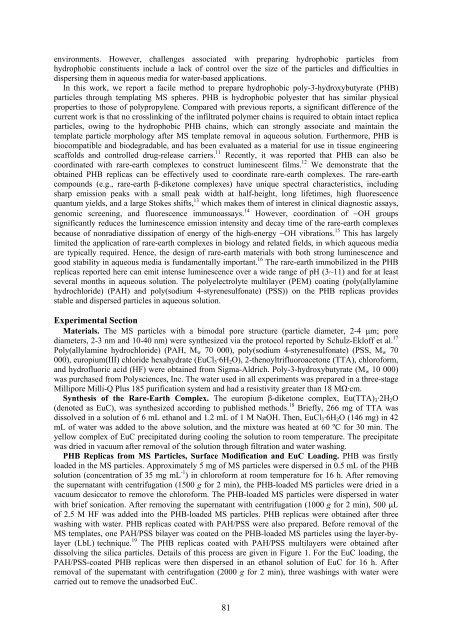Workshop proceeding - final.pdf - Faculty of Information and ...
Workshop proceeding - final.pdf - Faculty of Information and ...
Workshop proceeding - final.pdf - Faculty of Information and ...
Create successful ePaper yourself
Turn your PDF publications into a flip-book with our unique Google optimized e-Paper software.
environments. However, challenges associated with preparing hydrophobic particles from<br />
hydrophobic constituents include a lack <strong>of</strong> control over the size <strong>of</strong> the particles <strong>and</strong> difficulties in<br />
dispersing them in aqueous media for water-based applications.<br />
In this work, we report a facile method to prepare hydrophobic poly-3-hydroxybutyrate (PHB)<br />
particles through templating MS spheres. PHB is hydrophobic polyester that has similar physical<br />
properties to those <strong>of</strong> polypropylene. Compared with previous reports, a significant difference <strong>of</strong> the<br />
current work is that no crosslinking <strong>of</strong> the infiltrated polymer chains is required to obtain intact replica<br />
particles, owing to the hydrophobic PHB chains, which can strongly associate <strong>and</strong> maintain the<br />
template particle morphology after MS template removal in aqueous solution. Furthermore, PHB is<br />
biocompatible <strong>and</strong> biodegradable, <strong>and</strong> has been evaluated as a material for use in tissue engineering<br />
scaffolds <strong>and</strong> controlled drug-release carriers. 11 Recently, it was reported that PHB can also be<br />
coordinated with rare-earth complexes to construct luminescent films. 12 We demonstrate that the<br />
obtained PHB replicas can be effectively used to coordinate rare-earth complexes. The rare-earth<br />
compounds (e.g., rare-earth β-diketone complexes) have unique spectral characteristics, including<br />
sharp emission peaks with a small peak width at half-height, long lifetimes, high fluorescence<br />
quantum yields, <strong>and</strong> a large Stokes shifts, 13 which makes them <strong>of</strong> interest in clinical diagnostic assays,<br />
genomic screening, <strong>and</strong> fluorescence immunoassays. 14 However, coordination <strong>of</strong> −OH groups<br />
significantly reduces the luminescence emission intensity <strong>and</strong> decay time <strong>of</strong> the rare-earth complexes<br />
because <strong>of</strong> nonradiative dissipation <strong>of</strong> energy <strong>of</strong> the high-energy −OH vibrations. 15 This has largely<br />
limited the application <strong>of</strong> rare-earth complexes in biology <strong>and</strong> related fields, in which aqueous media<br />
are typically required. Hence, the design <strong>of</strong> rare-earth materials with both strong luminescence <strong>and</strong><br />
good stability in aqueous media is fundamentally important. 16 The rare-earth immobilized in the PHB<br />
replicas reported here can emit intense luminescence over a wide range <strong>of</strong> pH (3~11) <strong>and</strong> for at least<br />
several months in aqueous solution. The polyelectrolyte multilayer (PEM) coating (poly(allylamine<br />
hydrochloride) (PAH) <strong>and</strong> poly(sodium 4-styrenesulfonate) (PSS)) on the PHB replicas provides<br />
stable <strong>and</strong> dispersed particles in aqueous solution.<br />
Experimental Section<br />
Materials. The MS particles with a bimodal pore structure (particle diameter, 2-4 μm; pore<br />
diameters, 2-3 nm <strong>and</strong> 10-40 nm) were synthesized via the protocol reported by Schulz-Ekl<strong>of</strong>f et al. 17<br />
Poly(allylamine hydrochloride) (PAH, M w 70 000), poly(sodium 4-styrenesulfonate) (PSS, M w 70<br />
000), europium(III) chloride hexahydrate (EuCl 3·6H 2 O), 2-thenoyltrifluoroacetone (TTA), chlor<strong>of</strong>orm,<br />
<strong>and</strong> hydr<strong>of</strong>luoric acid (HF) were obtained from Sigma-Aldrich. Poly-3-hydroxybutyrate (M w 10 000)<br />
was purchased from Polysciences, Inc. The water used in all experiments was prepared in a three-stage<br />
Millipore Milli-Q Plus 185 purification system <strong>and</strong> had a resistivity greater than 18 MΩ·cm.<br />
Synthesis <strong>of</strong> the Rare-Earth Complex. The europium β-diketone complex, Eu(TTA) 3·2H 2 O<br />
(denoted as EuC), was synthesized according to published methods. 18 Briefly, 266 mg <strong>of</strong> TTA was<br />
dissolved in a solution <strong>of</strong> 6 mL ethanol <strong>and</strong> 1.2 mL <strong>of</strong> 1 M NaOH. Then, EuCl 3·6H 2 O (146 mg) in 42<br />
mL <strong>of</strong> water was added to the above solution, <strong>and</strong> the mixture was heated at 60 ºC for 30 min. The<br />
yellow complex <strong>of</strong> EuC precipitated during cooling the solution to room temperature. The precipitate<br />
was dried in vacuum after removal <strong>of</strong> the solution through filtration <strong>and</strong> water washing.<br />
PHB Replicas from MS Particles, Surface Modification <strong>and</strong> EuC Loading. PHB was firstly<br />
loaded in the MS particles. Approximately 5 mg <strong>of</strong> MS particles were dispersed in 0.5 mL <strong>of</strong> the PHB<br />
solution (concentration <strong>of</strong> 35 mg mL -1 ) in chlor<strong>of</strong>orm at room temperature for 16 h. After removing<br />
the supernatant with centrifugation (1500 g for 2 min), the PHB-loaded MS particles were dried in a<br />
vacuum desiccator to remove the chlor<strong>of</strong>orm. The PHB-loaded MS particles were dispersed in water<br />
with brief sonication. After removing the supernatant with centrifugation (1000 g for 2 min), 500 μL<br />
<strong>of</strong> 2.5 M HF was added into the PHB-loaded MS particles. PHB replicas were obtained after three<br />
washing with water. PHB replicas coated with PAH/PSS were also prepared. Before removal <strong>of</strong> the<br />
MS templates, one PAH/PSS bilayer was coated on the PHB-loaded MS particles using the layer-bylayer<br />
(LbL) technique. 19 The PHB replicas coated with PAH/PSS multilayers were obtained after<br />
dissolving the silica particles. Details <strong>of</strong> this process are given in Figure 1. For the EuC loading, the<br />
PAH/PSS-coated PHB replicas were then dispersed in an ethanol solution <strong>of</strong> EuC for 16 h. After<br />
removal <strong>of</strong> the supernatant with centrifugation (2000 g for 2 min), three washings with water were<br />
carried out to remove the unadsorbed EuC.<br />
81
















